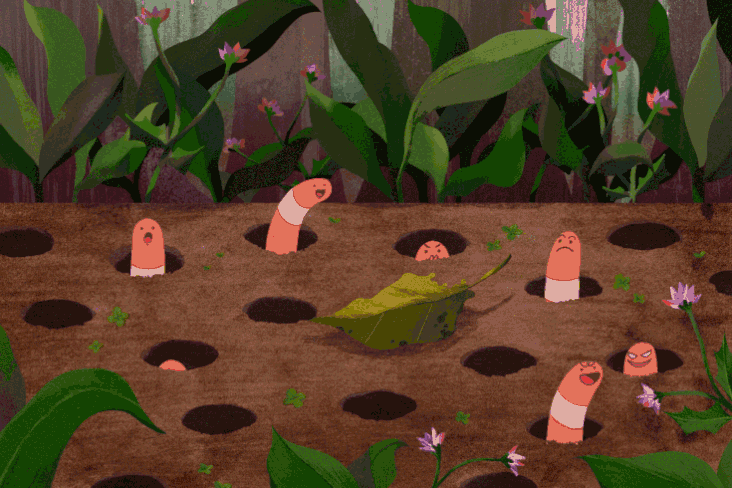In August 2021, Michael McTavish received an unexpected Facebook message: in some Toronto and Hamilton neighbourhoods, gardeners were reporting an unusual presence in the soil. McTavish is an expert in earthworms and conducts postdoctoral research at the University of Toronto. Soon, he found himself standing in one of those gardeners’ yard with an unusually energetic worm in his hand and a sinking feeling in his heart.
Though McTavish had previously seen this specimen only in videos and pictures, it was immediately clear what it was: a jumping worm, so named because of their startling tendency to thrash around, as if electrocuted, when disturbed. “They are just kind of upsetting,” says McTavish.
And jumping worms aren’t only upsetting for this creepy behaviour. Since one species was first recorded in North America, in the 1930s—one theory posits that they were introduced via some cherry trees Japan donated to Washington, DC, and Bethesda, Maryland, in the 1910s—these creatures have wriggled their way across at least thirty-eight states and now appeared to have moved to Canada too. The Toronto reports were among the first confirmed sightings of jumping worms in the country; they’d previously been found only once before, close to the American border in Windsor. Not long after McTavish received his message, the worms were detected in Nova Scotia and New Brunswick as well.
Wherever they land, jumping worms, whose roughly palm-length bodies have a distinctive pale band encircling one end, have made their presence known. They can congregate in densities as high as 200 worms per square metre and chew through the top layer of organic matter in the soil, leaving behind a loose, easily eroded dirt that resembles coffee grounds. Forests, which seem to be particularly appealing environments for jumping worms, can lose as much as 95 percent of their layer of fallen leaves in a four-month period due to these infestations, according to one study in Wisconsin. This means that the green carpet of forest understory, which includes tree seedlings and wildflowers such as trilliums and lady’s slippers, is quickly transformed into bare dirt.
Carly Ziter, an assistant professor in the department of biology at Concordia University, started studying jumping worms a few years ago, while completing her PhD at the University of Wisconsin–Madison. She says that, in places where jumping worms are found—including, incidentally, in the university’s arboretum in 2013—they can leave a notable impact. They break down nutrients in the soil faster than plants can absorb them. “We often hear that earthworms are like a gardener’s best friend.” says Ziter. “But these jumping worms are doing their job a little too well.”
For scientists, the discovery of jumping worms in Toronto is distressing though unsurprising based on the worms’ growing territory. It has also drawn attention to a troubling truth about our relationship with worms in general: though we’ve gotten used to these slimy critters appearing on our sidewalks after a rainstorm or speared on the ends of fishing hooks, most species of earthworm found in Canada are non-native, and many are invasive. As recent arrivals, they’ve been quietly and slowly reshaping our ecosystems—though the extent of their damage may soon become all too clear. The arrival of jumping worms is just the latest reminder of the many ways earthworms are threatening to exacerbate environmental change and reshape our natural world.
Scientists use a refrain to sum up in the impact of earthworms in ten pithy syllables: “Good in your garden, bad in the forest.” It’s a quip that can sometimes come as a surprise to people used to thinking of earthworms as symptoms of healthy soil.
In Canada’s northern forests, there’s increasing evidence of a worm problem. According to research from 2013, tiny soil invertebrates, like mites and springtails, decrease in abundance by more than 50 percent when earthworms are present. These minute creatures play an important role in the decomposition and nutrient-cycling of plants, and their decline can likely be attributed to the rapid way earthworms devour leaf litter. Earthworms may also be associated with above-ground changes to biodiversity: in northern Alberta, the distribution of American robins—a generalist species that adapts well to disturbed habitats—may be, in this case, the proverbial early bird. Their growing range throughout the province mirrors the spread of earthworms, a favoured prey. And earthworms, it seems, are spreading everywhere. Research on their presence in northern US forests, where invasions are more advanced, suggests that they could have cascading effects including everything from more severe drought to greater human allergies.
According to one paper, the full monetary cost of earthworm invasions in North America has not been quantified because of the wigglers’ “social standing” as a normal and even healthy part of every ecosystem—a standing that can be traced, to a significant degree, to one figure. When Charles Darwin published his first paper looking at earthworms in sediment displacement, in 1838, his fellow geologists were nonplussed. Few believed the humble worm capable of the earth-moving capacity Darwin attributed to it.
But Darwin was convinced of these creatures’ significant abilities. Unfazed by his colleagues’ skepticism, he spent subsequent years subjecting earthworms to a barrage of experiments to discover their qualities. He tested everything from their sensory capabilities (“indifferent to shouts,” he concluded, but responsive to vibration when plunked on top of a piano) to assessing their dietary preferences (raw fat was a particular favourite).
Yet Darwin’s most extensive examinations concerned how earthworms shape soil. Darwin hypothesized that earthworm activity was what caused stones and even the foundations of buildings to sink into the ground. Many structures simply weren’t safe from these tiny engineers, he cautioned. To study his hypothesis, he enlisted family members to assess how much dirt worms could move. For a full year, a niece collected all the castings (otherwise known as worm poop) from sections of a family estate. Based on this data, Darwin estimated that worms brought about 7.6 tons of soil per acre to the surface annually. In other estimates, he concluded that figure could be as much as fifteen tons.
Descriptions of these experiments were assembled into an 1881 book, The Formation of Vegetable Mould through the Action of Worms with Observations on their Habits. It became Darwin’s bestselling title in his own lifetime and helped entrench the public perception of worms as agents of healthy ecosystems. “It may be doubted whether there are many other animals which have played so important a part in the history of the world, as have these lowly organized creatures,” Darwin wrote.
But that book was written about English fields and gardens, in which many earthworms are native. By contrast, nearly all native species of earthworms in Canada were wiped out over 12,000 years ago, during the last period of glaciation.
Earthworms, we now know, have been present in southern Canada for only a few short centuries, the first having hitched a ride with colonizing Europeans, either in the soil used as ship ballast or tucked into the roots of transported plants. These earthworms flourished in, and supported the flourishing of, many gardens and farms, which, incidentally, were in turn modified and began to look a lot like Europe. While worms have been welcomed as industrious partners in southern agricultural environments—where their feeding and burrowing adds nutrients and improves soil drainage—until recently, less thought has been given to whether earthworms were making their way farther north and what their spread would mean.
This is why, on a trip to the boreal forest about 200 kilometres northeast of Edmonton, University of Alberta biologist Erin Bayne was surprised when the log he was sitting on rolled out from under him and he found earthworms wriggling away underneath.
This was in the early 2000s. At that time, there had been research on earthworms in North America’s temperate forests—moderate-climate ecosystems made up mostly of hardwood species—but little work on earthworms in the Canadian boreal, that northern sweep of coniferous trees recognized as one of the largest stretches of intact forest left on the planet. Historically, when Bayne spoke to fellow researchers about his worm discovery, they were skeptical that the presence of earthworms could be significant—at the time, it was seen as less significant than other shifts being observed in the region, like declines in the caribou population.
But Bayne suspected that earthworms, which are part of a group of species known as “ecosystem engineers” due to their ability to restructure entire environments, could significantly change the boreal forest. His graduate student Erin Cameron set out to investigate.
Cameron, who is now an assistant professor at Saint Mary’s University, in Halifax, says part of the challenge was figuring out how the worms had arrived in northern Alberta. She found that earthworms were most common near established roads and at boat launches, which suggested that they were being introduced by vehicle traffic—potentially by cocoons getting stuck in tire treads and even by anglers dumping unused bait at the ends of fishing trips.
This second hypothesis seems to be key in understanding the spread. While fishers may believe they are doing good by sparing a few unused worms, they’ve actually hastened the spread of a slow-motion invasion that may be impossible to turn back.
As effective as earthworms are at changing ecosystems, they can’t get to new territories on their own. They’re slow, and they like to stay put. Cameron’s research has found that worms, on their own power, are wiggling through the boreal at a rate of approximately seventeen metres each year. But, if people are constantly sprinkling more earthworms throughout the landscape, the territory covered can become vast, making the earthworm-human relationship a particularly significant one.
Joshua Steckley first witnessed this relationship as a teenager. Driving through rural southwestern Ontario one night, he noticed lights flashing in a farmer’s field and assumed that the shadowy figures were up to no good, possibly digging up illicit money. “I told one of my friends the next day at the school, and he was a farm kid. He’s like, ‘Oh, no, there’s no money. It’s just worm pickers.”
Lumbricus terrestris—the common earthworms people find in their gardens, which are often called dew worms or Canadian nightcrawlers in fishing circles—are one of the worm species that were transported from Europe and have settled into their new home so successfully that they’ve emerged as a valuable commodity. According to Steckley’s later research on the subject, demand for these worms as fishing bait exploded as recreational fishing became popular in the wake of the Second World War. But earthworms defy attempts at commercial cultivation and have to be plucked from the wild. In the 1980s, southwestern Ontario, with its rich soil, abundant volume of introduced nightcrawlers, and steady supply of immigrant labour, quickly eclipsed the other worm-producing regions of North America. By the time Steckley drove past the worm pickers, Ontario had become the epicentre of global nightcrawler production, with an estimated 500 million to 700 million worms picked and shipped across North America every year.
Steckley, who is now a doctoral candidate at the University of Toronto researching Ontario’s bait-worm industry, says that he was actually right about his initial impression: there were bags of money in that farmer’s field, at least in the figurative sense. Worm pickers usually make around $30 per 1,000 worms, and a picker in the right conditions can scoop up to 20,000 worms a night.
“Farmers who rent their land [for an entire year] can make more from worm pickers than any other crop that they feasibly plant,” says Steckley, who’s heard of rents of up to $1,500 an acre. The industry is worth around $230 million today, Steckley estimates.
Despite the spread, Steckley says there have been few efforts to regulate its downstream environmental effects—in fact, most people he’s encountered have been unaware that earthworms are invasive. “This is really an underground economy in kind of all senses of the word,” he says.
The impact of these worms is not confined to southern Ontario. Nightcrawlers are sold across North America, where they’re taken into the woods by anglers and introduced into the wild. When Cameron was conducting her graduate research, she occasionally came across people fishing and warned them that using worms had consequences. “A lot of anglers would say that they did dump their bait because they thought that was the nice thing to do,” she says.
The extent of our earthworm invasion’s risk to the ecosystem if it continues unabated is not yet known. But, in the boreal forest, most of the carbon is stored in organic matter—that thick layer of fallen leaves, roots, moss, and rotting wood that, under normal conditions, decomposes slowly. But deep-burrowing earthworms feed on this material and mix it with the mineral layer underneath. In some cases, carbon is released, contributing to climate change. Justine Lejoly, who is conducting doctoral work with the University of Alberta and the Canadian Forest Service, found that, in some invaded parts of the Canadian boreal, 96 percent of this layer has disappeared. “Most of the forest floor is gone, so that means a lot of carbon is gone,” she says. This finding, which Lejoly made alongside her supervisor Sylvie Quideau is striking because 28 percent of the boreal forest is found in Canada and as much as one-third of terrestrial carbon is stored in the boreal worldwide.
Research now suggests that almost 50 percent of the boreal in northeastern Alberta could eventually be invaded by earthworms as temperatures rise and their territory spreads. (Most species of earthworm die in subzero winters, therefore our warming climate only exacerbates the problem.) As earthworms continue their spread, their effects on our climate arithmetic could be staggering.
“Canada’s entire carbon budget, in the way that we calculate it for boreal forests, could be messed up by earthworms,” says Bayne. “That’s how big an effect they theoretically can have.”
Luckily, the spread is still slow, and in the meantime, there are steps that can be taken to mitigate earthworms’ effects. Warning labels can be introduced on bait containers, or non-artificial bait can be banned entirely. We can limit the number of new roads built in the boreal or require vehicles and equipment travelling deep into the northern forest to be thoroughly cleaned first. Either way, researchers say, the first step may be getting people to recognize that our relationship with worms is a lot more complicated than it may appear.
To raise this awareness, jumping worms may have an important role to play. The discovery of this new arrival has travelled far in the media and among backyard gardeners, with many being rightfully concerned. Given that there is little hope of eradicating jumping worms from an area they’ve already invaded—pesticides are not an effective solution, as their use would harm too many other species—it’s likely that we’ll be stuck with these worms in our suburbs and cities, similar to how earthworms took root before them. But, since they’re here—and since they’re so viscerally upsetting—researchers say the public concern is an opportunity to educate people about the problems with worms more generally. After all, they have the power to remake the world, for better and for worse.




